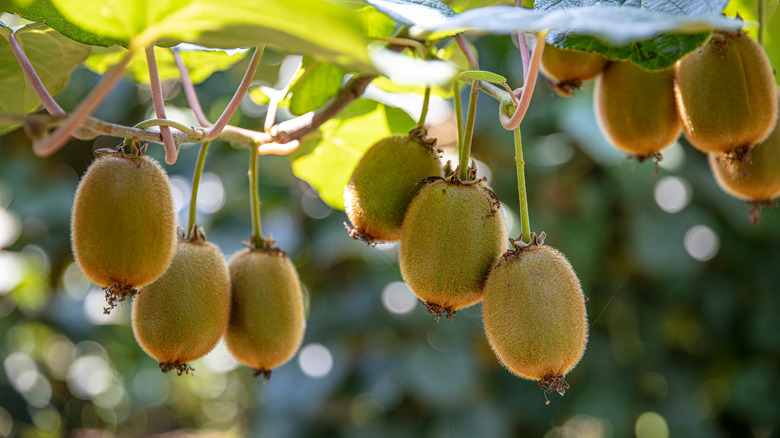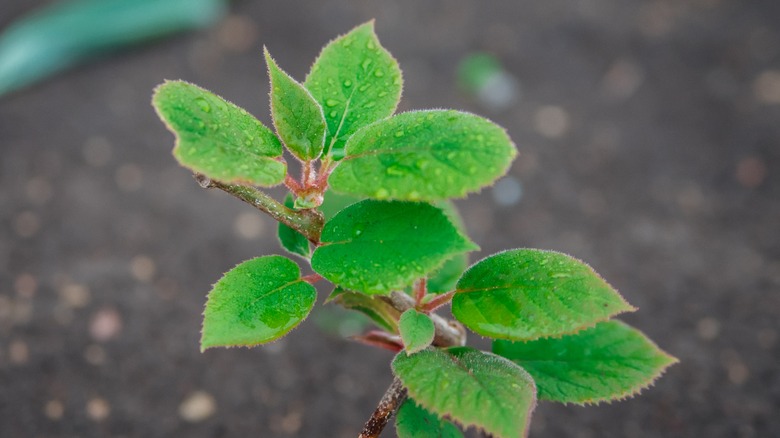TikTok Shares The Key To Growing Delicious, Juicy Kiwi In Your Garden
The kiwi plant (Actinidia deliciosa) is a vigorous climbing vine known for its brown-skinned, fuzzy fruits. Growing your own kiwi vine is easier than you might think — simply harvesting seed from your store-bought kiwi fruit can be the first step in propagating your very own plant. Suitable to grow in USDA zones 7a through 9b (they are one of the best plants to grow in zone 9), your homegrown vine may even produce kiwis. However, even if they don't, this climber makes an attractive addition to your temperate garden with or without fruits.
The deciduous, woody vines can reach 26 to 38 feet in length, provided they have adequate support. The leaves are heart-shaped, ovate, and dark green in color. In early summer, kiwi vines bear clusters of creamy white flowers, followed by fruits in the fall. Kiwi plants are dioecious, meaning male and female plants are separate — it is only possible to tell the plants apart at bloom. To grow vines that bear fruit, around one male plant for every six to eight female plants is recommended. Note that some cultivars have been bred to be self-fertile; however, this won't be the case for your harvested seeds. Harvesting kiwi seeds will be a game of luck compared to purchasing commercial cultivars, but think of that as part of the fun!
The key to successfully germinating your store-bought kiwi seeds
Choose a kiwi fruit that is fully ripe to have the best chance at harvesting mature seeds. First, cut your kiwi in half long ways and use a butter knife or teaspoon to scoop out the tiny black seeds. Place the seeds in a bowl of water to separate healthy seeds from dead seeds — healthy ones will sink to the bottom, while non-viable ones will float. Discard any floating seeds and lay the remaining healthy seeds on a dry paper towel. Gently scrape them using a butter knife to begin removing the pulp. Transfer the seeds onto a fresh paper towel, repeating this process two to three times until the seeds are clean, dry, and slightly bouncy.
Now, they are ready for germination. Lay the seeds on a clean paper towel and spray with water to moisten them. Fold the towel in half and place it in a plastic ziplock bag to create a humid environment. Place the sealed bag in a warm, bright location away from direct sunlight. Check daily for signs of sprouting — germination should take 10 to 14 days. Once the seeds have sprouted, plant them in pots with a well-draining seed starting mix. Cover the pots with a plastic bag and place them in a warm, bright location. Once the seedlings are large enough to handle, transplant them into individual pots.
How to care for kiwi fruit vines
Keep your kiwi seedlings indoors or in a greenhouse for three to four months, maintaining a temperature between 60 to 80 degrees Fahrenheit. Once they are well-established, plant them out in the garden in the spring or summer. As these climbing plants are not self-supporting, they will need a strong, permanent structure (such as a trellis that maximizes your outdoor space) — choose a sheltered location that receives full sun, such as a south- or east-facing wall. Kiwi plants prefer well-draining soil rich in organic matter, so incorporate compost into the ground before planting. For the first two years, these plants will require frequent watering through the growing season, but take care not to overwater as the roots are sensitive to sitting in waterlogged soil.
Fertilize monthly through the spring and early summer with a nitrogen-rich fertilizer and avoid fertilizing young plants after July — this will encourage new, delicate growth prone to frost damage in the winter. Prune your kiwi vines twice a year in the winter and summer to control growth and encourage fruiting. Remember to retain part of the previous year's growth as flowers emerge on new shoots that grow on last year's stems. Kiwi plants may take three to five years before producing fruits. Consider that plants grown from seed are not genetically identical to the parent, so if your kiwi vine does produce fruits, they may not look or taste the same as your shop-bought kiwi.

